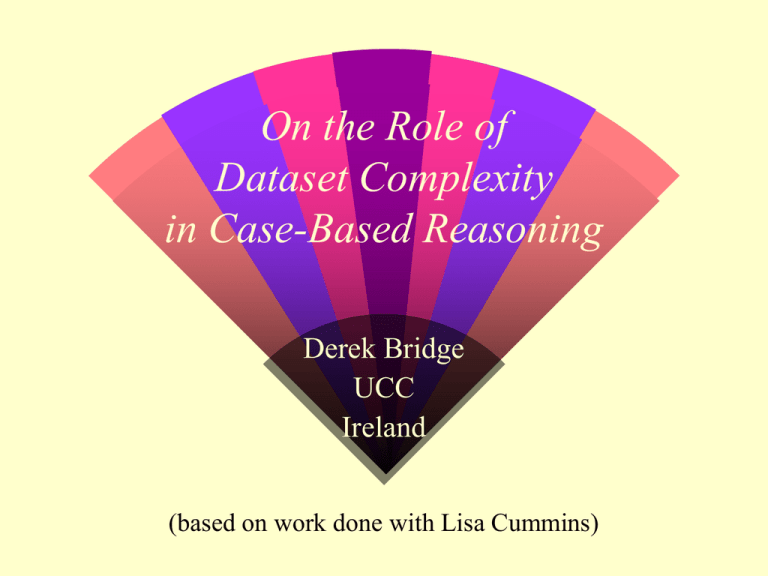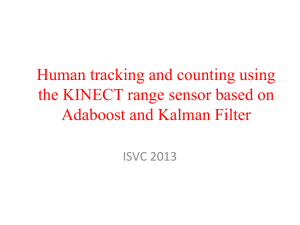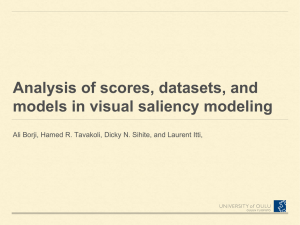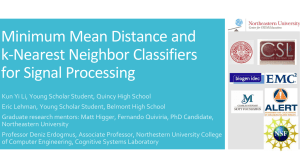On the Role of Dataset Complexity in Case
advertisement

On the Role of Dataset Complexity in Case-Based Reasoning Derek Bridge UCC Ireland (based on work done with Lisa Cummins) Dataset classifier CB case base maintenance algorithm CB Overview Dataset complexity measures Classification experiment Case base maintenance experiment Going forward Overview Dataset complexity measures Classification experiment Case base maintenance experiment Going forward Dataset Complexity Measures • Measures of classification difficulty • apparent difficulty, since we measure a dataset which samples the problem space • Little impact on CBR • Fornells et al., ICCBR 2009 • Cummins & Bridge, ICCBR 2009 • (Little impact on ML in general!) Dataset Complexity Measures • Survey of 12 geometrical measures • Ho & Basu, 2002 • DCoL: open source C++ library of 13 measures • Orriols-Puig et al., 2009 • We have found 4 candidate measures in the CBR literature Overlap of attribute values F1 Maximum Fisher’s Discriminant Ratio F2' Volume of Overlap Region F3' Maximum Attribute Efficiency F4' Collective Attribute Efficiency Separability of classes N1' Fraction of Instances on a Boundary N2 Ratio of Average Intra/Inter Class Distance N3 Error Rate of a 1NN classifier L1 Minimized Sum of Error Distance of a Linear Classifier L2 Training Error of a Linear Classifier C1 Complexity Profile C2 Similarity-Weighted Complexity Profile N5 Separability Emphasis Measure Manifold Topology & Density L3 Nonlinearity of a Linear Classifier N4 Nonlinearity of a 1NN Classifier T1 Fraction of Maximum Covering Spheres T2 Number of Instances per Attribute T3 Dataset Competence Dataset Complexity Measures • Desiderata • • • • • • Predictive Independent of what is being analyzed Widely applicable across datasets Cheap-to-compute Incremental Transparent/explainable Overview Dataset complexity measures Classification experiment Case base maintenance experiment Going forward Classification experiment • 25 datasets • 14 Boolean classification; 11 multi-class • 21 numeric-valued attributes only (12 Boolean classification; 9 multi-class) • 4 Weka classifiers trained on 60% of dataset • • • • Neural Net with 1 hidden layer SVM with SMO J48 IBk with k = 3 • Error measured on 20% of dataset • Repeated 10 times An example of the results Dataset NN SVM J48 IBk Mean N1' Iris 2.67 4.00 5.00 2.67 3.58 0.13 Lung Cancer 58.00 50.00 46.00 56.00 52.50 0.75 An example of the results 1.00 0.90 0.80 0.70 N1' 0.60 0.50 0.40 0.30 0.20 0.10 0.00 0.00 10.00 20.00 30.00 40.00 50.00 60.00 Error % Correlation coefficient: 0.96 N1' Fraction of instances on a boundary • Build a minimum spanning tree 1 3 5 6 4 1 4 2 5 8 6 3 4 5 2 • Compute fraction of instances directly connected to instances of a different class • Shuffle dataset, repeat, & average Other competitive measures • N3 Error Rate of a 1NN Classifier • leave-one-out error rate of 1NN on the dataset • N2 Ratio of Average Intra/Inter Class Distance • sum distances to nearest neighbour of same class • divide by sum of distances to nearest neighbour of different class • L2 Training Error of a Linear Classifier • build, e.g., SVM on dataset • compute error on original dataset • problems with multi-class; problems with symbolic values C1 Complexity Profile • Computed for each instance, with parameter K [Massie et al. 2006] Pk For K = 3 1 0.9 0.8 0.7 0.6 0.5 0.4 0.3 0.2 0.1 0 1 0.67 0.5 1 2 k • For a dataset measure, compute average complexity 3 Other measures from CBR • C2 Similarity-Weighted Complexity Profile • use similarity values when computing Pk • N5 Separability Emphasis Measure [Fornells et al. ’09] • N5 = N1' × N2 • T3 Dataset Competence [Smyth & McKenna ’98] • competence groups based on overlapping coverage sets • group coverage based on size and similarity • dataset competence as sum of group coverages Their predictivity • C1 Complexity Profile • Correlation coefficient: 0.98 • C2 Similarity-Weighted Complexity Profile • Correlation coefficient: 0.97 • N5 Separability Emphasis Measure • Between N1' and N2 • T3 Dataset Competence • Correlation coefficient: near zero Summary of experiment • Very predictive • C1 Complexity Profile • N3 Error Rate of 1NN Classifier • N1' Fraction of Instances on a Boundary • Predictive but problems with applicability • L2 Training Error of a Linear Classifier • Moderately predictive • N2 Ratio of Average Intra/Inter Class Distance • All are measures of separability of classes Overview Dataset complexity measures Classification experiment Case base maintenance experiment Going forward Meta-CBR for Maintenance • Case base maintenance algorithms seek to: • delete noisy cases • delete redundant cases • Different case bases require different maintenance algorithms • The same case base may require different maintenance algorithms at different times in its life cycle • We have been building classifiers to select maintenance algorithms Meta-Case Base F1: 0.9 : 0.3 F2F : 10.4 F : 0.7 …F2: 10.4 F : 0.9 …F2: 10.4 F : 0.0 …F2: 10.4 : 0.3 : 10.4 RENN…F2F : 0.2 : 10.4 RENN…F2F RENN…F2: 0.3 RENN… RENN RENN CRR CB F1: 0.2 F2: 0.4 … kNN Classifier RENN Case Base Maintenance Experiment • Training (building the meta-case base) • From 60% of each dataset, create a case base • Create a meta-case to describe this case base • attributes are complexity measures • problem solution • • • • run a small set of maintenance algorithms on each case base record % deleted record accuracy on the next 20% of each dataset maintenance algorithm with highest harmonic mean of % deleted and accuracy becomes this meta-case’s solution • But, we use feature selection to choose a subset of the complexity measures • wrapper method, best-first search Case Base Maintenance Experiment • Testing • Target problem is a case base built from remaining 20% of each dataset • attributes again are complexity measures • Ask the classifier to predict a maintenance algorithm • Run the algorithm, record % deleted, accuracy and their harmonic mean • Compare meta-CBR with perfect classifier and ones that choose same algorithm each time Example results Classifier Cases deleted (%) Accuracy (%) Harmonic mean Choose-best 72.37 71.86 69.56 Meta-CBR 66.32 70.76 63.98 Choose ICF 64.54 69.63 62.29 Choose CBE 57.11 72.64 60.41 Which measures get selected? F2' Volume of Overlap Region • For a given attribute, a measure of how many values for that attribute appear in instances labelled with different classes a a Quick computation of F2 min min max min min max max a max a A problem for F2 min min max max a F2' Our version • o'(a) = count how many values are in the overlap • r'(a) = count the number of values of a o(ai ) F 2 i 1 r ( ai ) n Summary of experiment • Feature selection • chose between 2 and 18 attributes, average 9.2 • chose range of measures, across Ho & Basu’s categories • always at least one measure of overlap of attribute values, e.g. F2' • but measures of class separability only about 50% of the time • But this is just one experiment Overview Dataset complexity measures Classification experiment Case base maintenance experiment Going forward Going forward • Use of complexity measures in CBR (and ML) • More research into complexity measures: • experiments with more datasets, different datasets, more classifiers,… • new measures, e.g. Information Gain • applicability of measures • missing values • loss functions • dimensionality reduction, e.g. PCA • the CBR similarity assumption and measures of case alignment [Lamontagne 2006, Hüllermeier 2007, Raghunandan et al. 2008]








